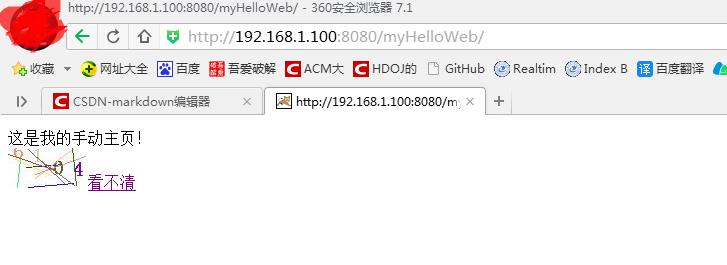Web---圖片驗證碼生成教程詳解-從簡單到複雜-從本地到前後臺
阿新 • • 發佈:2019-01-08
首先,我們先來看本地如何生成圖片驗證碼的,再來寫輸出到網頁的驗證碼如何實現。
先來看最簡單的—實現的功能是,將一個字串變成圖片寫入到檔案中
實現程式碼:
package cn.hncu.img;
import java.awt.Graphics;
import java.awt.image.BufferedImage;
import java.io.FileNotFoundException;
import java.io.FileOutputStream;
import java.io.IOException;
import javax.imageio.ImageIO;
//該類包含一些用來查詢 ImageReader 和 ImageWriter 以及執行簡單編碼和解碼的靜態便捷方法。 結果:
上面那個很簡單,對不對,我們看到的驗證碼都不是這樣的,那好,我們給它加點干擾線,背景色,字元和y座標隨機生成。
有干擾線、背景色的驗證碼-寫入檔案
演示程式碼:
package cn.hncu.img;
import java.awt.Color;
import java.awt.Font;
import java.awt.Graphics;
import java.awt.image.BufferedImage;
import java.io.FileNotFoundException;
import java.io.FileOutputStream;
import java.io.IOException;
import java.util.Date;
import java.util.Random;
import javax.imageio.ImageIO;
//該類包含一些用來查詢 ImageReader 和 ImageWriter 以及執行簡單編碼和解碼的靜態便捷方法。
import org.junit.Test;
public class ImgDemo {
//把上面的字串改成我們平時用的驗證碼---生成幾個隨機數字,有背景色和干擾線
@Test
public void ImgDemo2() throws FileNotFoundException, IOException{
int width = 80;
int height= 40;
int lines = 10;
BufferedImage img = new BufferedImage(width, height, BufferedImage.TYPE_INT_RGB);
Graphics g = img.getGraphics();
//設定背景色
g.setColor(Color.white);
g.fillRect(0, 0, width, height);//畫背景
//填充指定的矩形。使用圖形上下文的當前顏色填充該矩形
//設定字型
g.setFont(new Font("宋體", Font.BOLD, 18));
//隨機數字
Date d = new Date();
//System.out.println(d.getTime());
Random r = new Random(d.getTime());
for(int i=0;i<4;i++){
int a = r.nextInt(10);//取10以內的整數[0,9]
int y = 10+r.nextInt(20); //10~30範圍內的一個整數,作為y座標
Color c = new Color(r.nextInt(255), r.nextInt(255), r.nextInt(255));
g.setColor(c);
g.drawString(""+a, 5+i*width/4, y);
}
//干擾線
for(int i=0;i<lines;i++){
Color c = new Color(r.nextInt(255), r.nextInt(255), r.nextInt(255));
g.setColor(c);
g.drawLine(r.nextInt(width), r.nextInt(height), r.nextInt(width), r.nextInt(height));
}
g.dispose();//類似於流中的close()帶動flush()---把資料刷到img物件當中
ImageIO.write(img, "JPG", new FileOutputStream("img/b.jpg"));
}
}
演示結果:
最後來看一個可以旋轉和放縮的驗證碼-寫到圖片本地檔案中
演示程式碼:
package cn.hncu.img;
import java.awt.Color;
import java.awt.Font;
import java.awt.Graphics;
import java.awt.Graphics2D;
import java.awt.geom.AffineTransform;
import java.awt.image.BufferedImage;
import java.io.FileNotFoundException;
import java.io.FileOutputStream;
import java.io.IOException;
import java.util.Date;
import java.util.Random;
import javax.imageio.ImageIO;
//該類包含一些用來查詢 ImageReader 和 ImageWriter 以及執行簡單編碼和解碼的靜態便捷方法。
import org.junit.Test;
public class ImgDemo {
@Test//可以旋轉和放縮的驗證碼
public void ImgDemo3() throws FileNotFoundException, IOException{
int width = 80;
int height = 40;
int lines = 10;
BufferedImage img = new BufferedImage(width, height, BufferedImage.TYPE_INT_RGB);
Graphics2D g2d = (Graphics2D)img.getGraphics();
g2d.setFont(new Font("宋體", Font.BOLD, 20));
Random r = new Random(new Date().getTime());
//設定背景色
g2d.setColor(new Color(r.nextInt(255), r.nextInt(255), r.nextInt(255)));
g2d.drawRect(0, 0, width, height);//繪製指定矩形的邊框。
g2d.setColor(new Color(r.nextInt(255), r.nextInt(255), r.nextInt(255)));
g2d.fillRect(0, 0, width, height);//填充指定的矩形。
for(int i=0;i<4;i++){
String str = ""+r.nextInt(10);
//處理旋轉
AffineTransform Tx = new AffineTransform();
Tx.rotate(Math.random(), 5+i*15, height-5);
//用弧度測量的旋轉角度,旋轉錨點的 X 座標,旋轉錨點的 Y 座標
//Tx.scale(0.7+Math.random(), 0.7+Math.random());
//x座標方向的縮放倍數,y座標方向的縮放倍數
g2d.setTransform(Tx);
Color c = new Color(r.nextInt(255), r.nextInt(255), r.nextInt(255));
g2d.setColor(c);
g2d.drawString(str, 2+i*width/4, height-13);
}
//干擾線
for(int i=0;i<lines;i++){
Color c = new Color(r.nextInt(255), r.nextInt(255), r.nextInt(255));
g2d.setColor(c);
g2d.drawLine(r.nextInt(width), r.nextInt(height), r.nextInt(width), r.nextInt(height));
}
g2d.dispose();
ImageIO.write(img, "JPG", new FileOutputStream("img/c.jpg"));
}
}
演示結果:
下面就要開始演示前臺的圖片驗證技術了。
前臺的圖片驗證技術
這個專案的結構圖:
index.jsp:
<%@ page language="java" import="java.util.*" pageEncoding="utf-8"%>
<!DOCTYPE HTML PUBLIC "-//W3C//DTD HTML 4.01 Transitional//EN">
<html>
<head>
<script type="text/javascript">
function changImg(){
var img = document.getElementById("servletImg");
var d = new Date();
var time = d.getTime();//如果沒有這個
//下面這一句不會起作用,因為瀏覽器的快取技術,圖片並不會重新整理
//img.src="/myHelloWeb/servlet/ImageServlet";
img.src="/myHelloWeb/servlet/ImageServlet?"+time;
//?號後面的東西是通過get方式傳遞的
}
</script>
</head>
<body>
這是我的手動主頁!
<br/>
<img id="servletImg" src="/myHelloWeb/servlet/ImageServlet" /><a href="javascript:changImg()">看不清</a>
</body>
</html>
web.xml:
<?xml version="1.0" encoding="UTF-8"?>
<web-app version="3.0"
xmlns="http://java.sun.com/xml/ns/javaee"
xmlns:xsi="http://www.w3.org/2001/XMLSchema-instance"
xsi:schemaLocation="http://java.sun.com/xml/ns/javaee
http://java.sun.com/xml/ns/javaee/web-app_3_0.xsd">
<display-name></display-name>
<servlet>
<description>This is the description of my J2EE component</description>
<display-name>This is the display name of my J2EE component</display-name>
<servlet-name>ImageServlet</servlet-name>
<servlet-class>cn.hncu.img.ImageServlet</servlet-class>
</servlet>
<servlet-mapping>
<servlet-name>ImageServlet</servlet-name>
<url-pattern>/servlet/ImageServlet</url-pattern>
</servlet-mapping>
<welcome-file-list>
<welcome-file>index.jsp</welcome-file>
</welcome-file-list>
</web-app>
ImageServlet.java
package cn.hncu.img;
import java.awt.Color;
import java.awt.Font;
import java.awt.Graphics;
import java.awt.image.BufferedImage;
import java.io.IOException;
import java.io.PrintWriter;
import java.util.Date;
import java.util.Random;
import javax.imageio.ImageIO;
import javax.servlet.ServletException;
import javax.servlet.http.HttpServlet;
import javax.servlet.http.HttpServletRequest;
import javax.servlet.http.HttpServletResponse;
public class ImageServlet extends HttpServlet {
public void doGet(HttpServletRequest request, HttpServletResponse response)
throws ServletException, IOException {
doPost(request, response);
}
public void doPost(HttpServletRequest request, HttpServletResponse response)
throws ServletException, IOException {
//告訴客戶端,輸出的格式
response.setContentType("image/jpeg");
int width = 80;
int height = 40;
int lines = 10;
BufferedImage img = new BufferedImage(width, height, BufferedImage.TYPE_INT_RGB);
Graphics g = img.getGraphics();
//設定背景色
g.setColor(Color.WHITE);
g.fillRect(0, 0, width, height);
//設定字型
g.setFont(new Font("宋體", Font.BOLD, 20));
//隨機數字
Random r = new Random(new Date().getTime());
for(int i=0;i<4;i++){
int a = r.nextInt(10);
int y = 10+r.nextInt(20);//10~30範圍內的一個整數,作為y座標
Color c = new Color(r.nextInt(255),r.nextInt(255),r.nextInt(255));
g.setColor(c);
g.drawString(""+a, 5+i*width/4, y);
}
//干擾線
for(int i=0;i<lines;i++){
Color c = new Color(r.nextInt(255),r.nextInt(255),r.nextInt(255));
g.setColor(c);
g.drawLine(r.nextInt(width), r.nextInt(height), r.nextInt(width), r.nextInt(height));
}
g.dispose();//類似於流中的close()帶動flush()---把資料刷到img物件當中
ImageIO.write(img, "JPG", response.getOutputStream());
}
}
演示結果:
下面這個是在index.jsp中:
如果是用這句:
img.src=”/myHelloWeb/servlet/ImageServlet”;
大家可以看看響應頭:

再看看用這句的響應頭:
img.src=”/myHelloWeb/servlet/ImageServlet?”+time;
多了個Date響應!
因為時間一直在變,所以每次點看不清,都會再向伺服器請求一次,而不會因為瀏覽器的快取,而不去請求了。
驗證碼就先到這裡結束啦。









